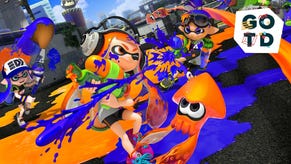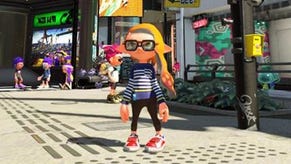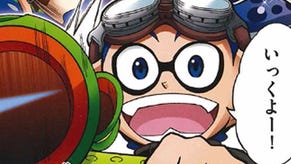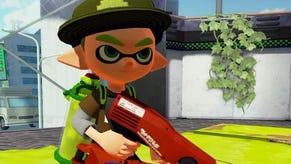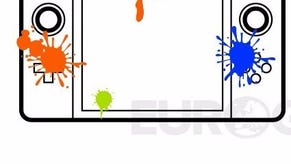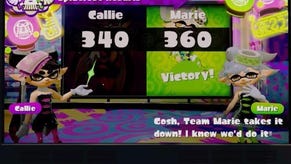Nintendo colours outside the lines in the lovable but irksome Splatoon
Stain alive?
Editor's note: This is an early impressions piece based on time spent with pre-release code of Splatoon. We'll have our full review up early next week, once we've had time with the game on fully populated servers.
Splatoon couldn't help but stand out when it was first revealed at E3 last year. For one, it was a complete surprise - a rarity at that most leaky and rehearsed annual mosh pit of rumour confirmation. It was also a new Nintendo IP, another rarity for a company that has preferred to lean heavily - and successfully - on the same core of characters that have endured since the 1980s.
The game doubled down on its unique nature as well. A multiplayer third-person shooter, it represented a dramatic change of direction for the company, finally embracing a style of play that had become the norm on PlayStation and Xbox but giving it a distinctively friendly Nintendo twist.
The setting is Inkopolis, a clean, futuristic Shibuya-like place that calls to mind Jet Set Radio, with its soundscape of loping dub reggae and stylish street art aesthetic. Its inhabitants, the Inklings, are strange human-squid hybrids who can switch forms at will, splattering paint on the floor in their biped guise then swimming through it as a squid, and their obsession is a manic form of paintball.
Following a quick tutorial which gets you up to speed on control and combat, you're dropped into the Inkopolis hub - a shiny, bustling town square area surrounded by shops selling clothing and weapons, a central tower into which you venture to start online matches, and a Battle Dojo for offline split-screen balloon popping sessions with a friend.
There are other features here as well. Explore a back alley and you'll find a mysterious figure who can procure costumes for you. Talk to any of the other characters and players mingling in the hub, and you'll get the option to request replicas of their clothing items - either because you like their style, or because you want their stat buffs.
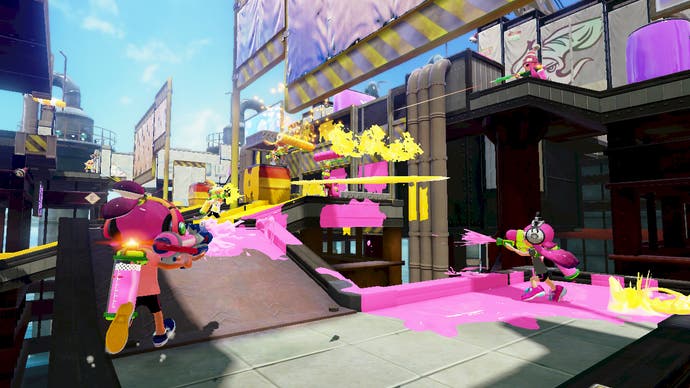
Also tucked away, this time down a manhole, is Splatoon's single player campaign - an element that has remained mostly secret throughout its pre-release hype, but which proves to be one of the most compelling parts of the game. It sees you tackling 13 stages, each filled with multiple standalone missions which mix paint-splatting shooting with some ingenious platforming challenges.
You'll paint moving walls and try to time your ascent, you'll load sponge cubes with paint to make them expand into usable platforms and you'll come up against an array of Octarian foes and bosses that force you to use your paint guns in different and clever ways. It's here where the Nintendo feel is strongest, as you can easily imagine the squid form as a new power-up in a 3D Mario title.
The heart of the game is multiplayer, however, and here the game sadly seems to be on less confident footing. Or tentacling.
At the start, only one option is open to you: Turf War. This is basically as close as Splatoon gets to a team deathmatch, though the splatting of other players is only a secondary concern. Matches are won by painting the floor of the arena, and at the end of the two minute bout the team whose colour dominates is declared the winner, with the relevant players getting an XP bonus. There are other advantages to having your colour dominate, since walking through an opposing team's paint slows you down, does damage and is impossible to swim through. The more of the map you paint, the harder you make life for the other team.
There's an immediate appeal to the combat that's hard to resist. The rhythm between dashing about, painting the world, and then diving into your painted area to both hide from enemies and restock your ink, is unique and compelling. The paint effects are similarly wonderful, with a tactile pleasure to their splat and squelch that is matched by the retina-searing acid bright colour scheme. Just running around, splurging gobs of neon pink or sky blue all over the place is an absolute joy.
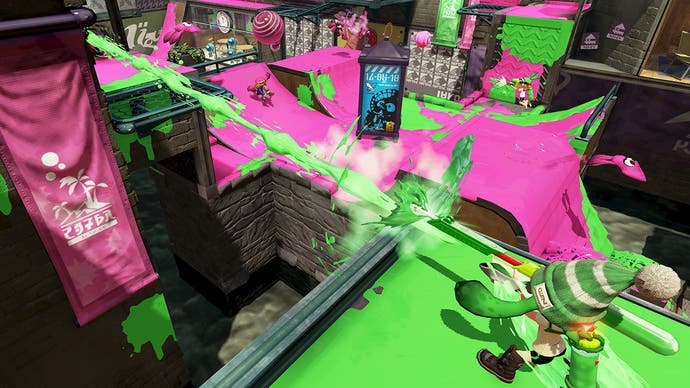
In terms of long-term depth, the game is harder to read. You don't even get to change your weapons until you've reached Level 4, as the stores refuse to serve you if you're not "fresh" enough. That means that while the initial rush is joyful, it is quickly tinged with frustration as your feeble default gun - which plops out paint with all the range and power of a blocked garden hose - is constantly outmatched by players who have unlocked better gear. In particular, the Splat Roller is the bane of these early matches. This gigantic paint roller not only allows the player to colour huge swathes of territory just by running around, it's also instant death for anyone who gets run over along the way.
Once you reach Level 4, these gadgets are available to you - along with a more sturdy rapid-fire weapon and a sniper rifle that shoots over longer range, but leaves only a thin trail of paint. Each weapon also has two support features - a secondary attack, usually some form of thrown bomb, turret or shield, and a special that is earned by painting terrain. These range from devastating tornadoes and foghorn attacks to tactical advantages that reveal enemy positions even when submerged in ink.
If you want a second match type to choose from, and Ranked Matches, you need to hit Level 10. There are only two match types in the core game - more will be added in post-launch updates, apparently - with Splat Zones being the other. In this mode, victory comes from painting designated areas in your colour and keeping them that way.
Regardless of mode, matches quickly settle into an odd mix of chaos and routine. Weapon accuracy varies, so don't expect to be pulling off headshots, and by and large successful strategies seem to be broad in nature. I've not seen much in the way of teamwork, with the specific reasons for victory or defeat remaining frustratingly elusive. Often, you can predict which team will win based on the weaponry they have equipped at the start of the match. An overpowered team will remain that way since there's no way to change your loadout when you respawn to better respond to the situation. Indeed, to change anything you need to quit out of the competitive play altogether, back to the Inkopolis hub, and then jump back into a lobby once you're happy with your loadout.
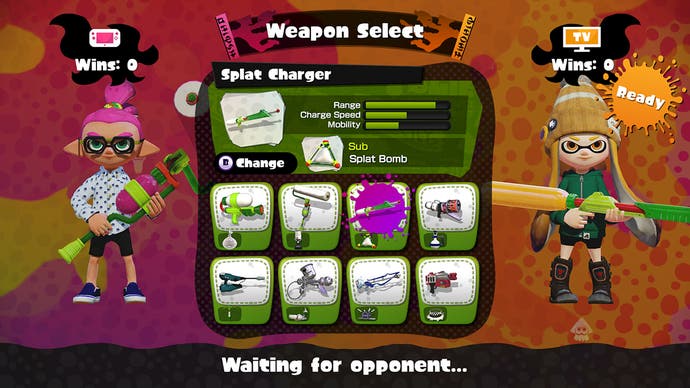
For all its exuberant presentation, multiplayer quickly becomes repetitive. It's only ever 4v4 with a two minute timer, and matches won't even start without a full lobby so even if you have six players or four, you'll have to wait. At least the game pad offers a fun Doodle Jump style minigame to keep you busy. Such delays likely won't be an issue when the game is new and well populated, but the fact the multiplayer is essentially inaccessible without a full lobby means there are question marks over its functionality once fairweather players move on. Will you still be able to get a match started in two years time? Let's hope so.
Most baffling of all, players have no say over which maps are used. There are only ever two maps available for each mode, selected via an automated daily rotation, which means that prolonged online play rapidly loses its charm as the experience of playing the same pair of maps over and over leads to short matches that blur into one another.
Taken together with the way it locks off so much content until you hit arbitrary levels it feels bizarrely restrictive, forcing players into a grind-like trajectory that gradually dishes out tools that make gameplay more interesting, even as the deliberately limited combinations of rules, maps and modes chip away at the initially intoxicating sugar rush appeal.
Sad to say, after only four or five hours of play I found my interest in the multiplayer side of the game almost completely gone, while it was the inventiveness and gleeful experimentation of the single player campaign which kept me coming back for more. If multiplayer made use of just some of the great concepts and ideas introduced in the campaign, it would be a far more engaging prospect for the long haul.
But I'm also aware that I may be in the minority on this one. Other players seem to be smitten with the multiplayer, and see the ingenious fingerprints of Nintendo EAD all over the game, not just in the single player missions. There's certainly lots here to enjoy, and even love, but for me it's too often poorly served by the game's weirdly obstructive nature. Hopefully by the time more modes have been added, and more players are playing with the full arsenal, these awkward wrinkles will hopefully have been smoothed out. For now, it's a game I'm admiring more for its energy and aesthetic than I'm enjoying for its supposedly core gameplay.


